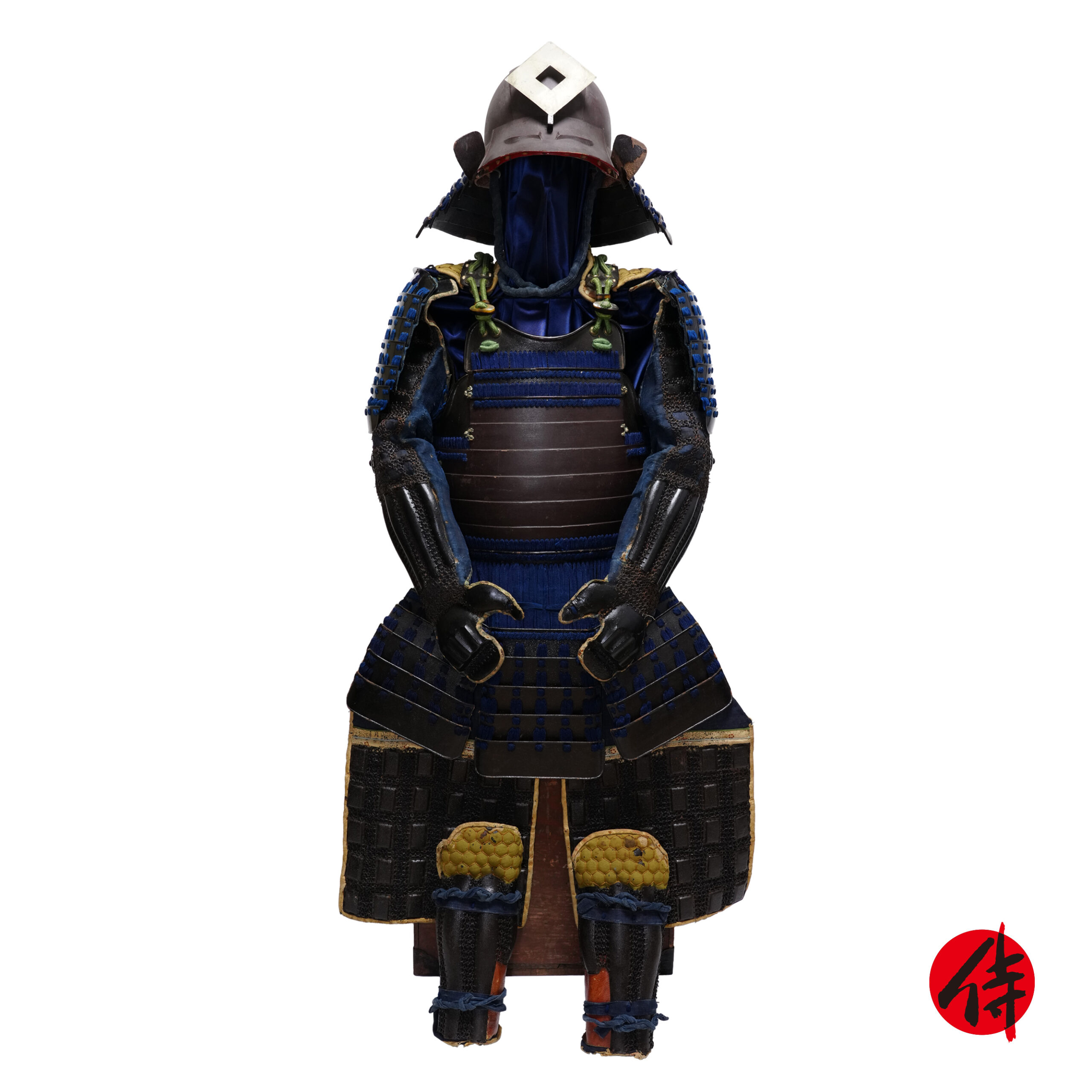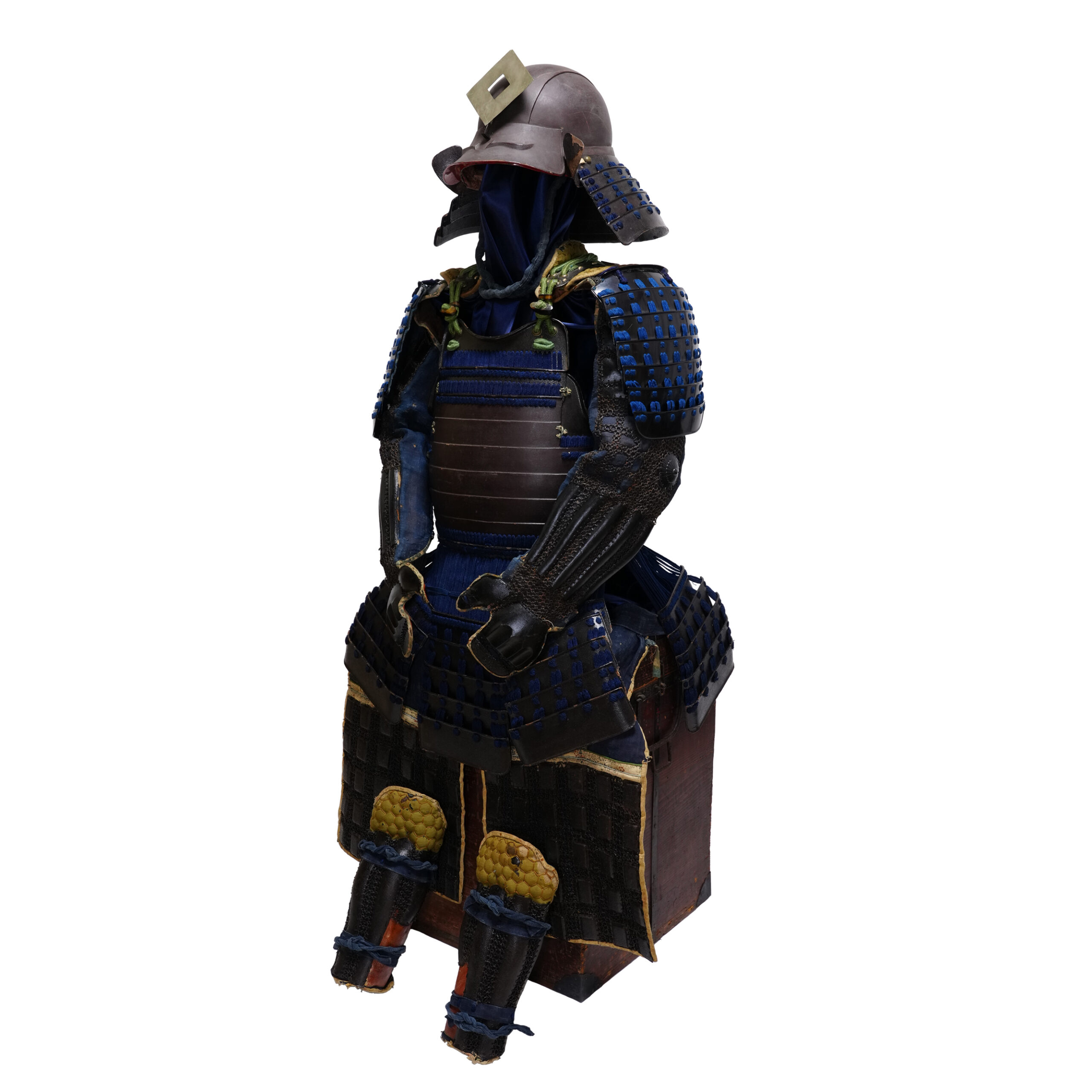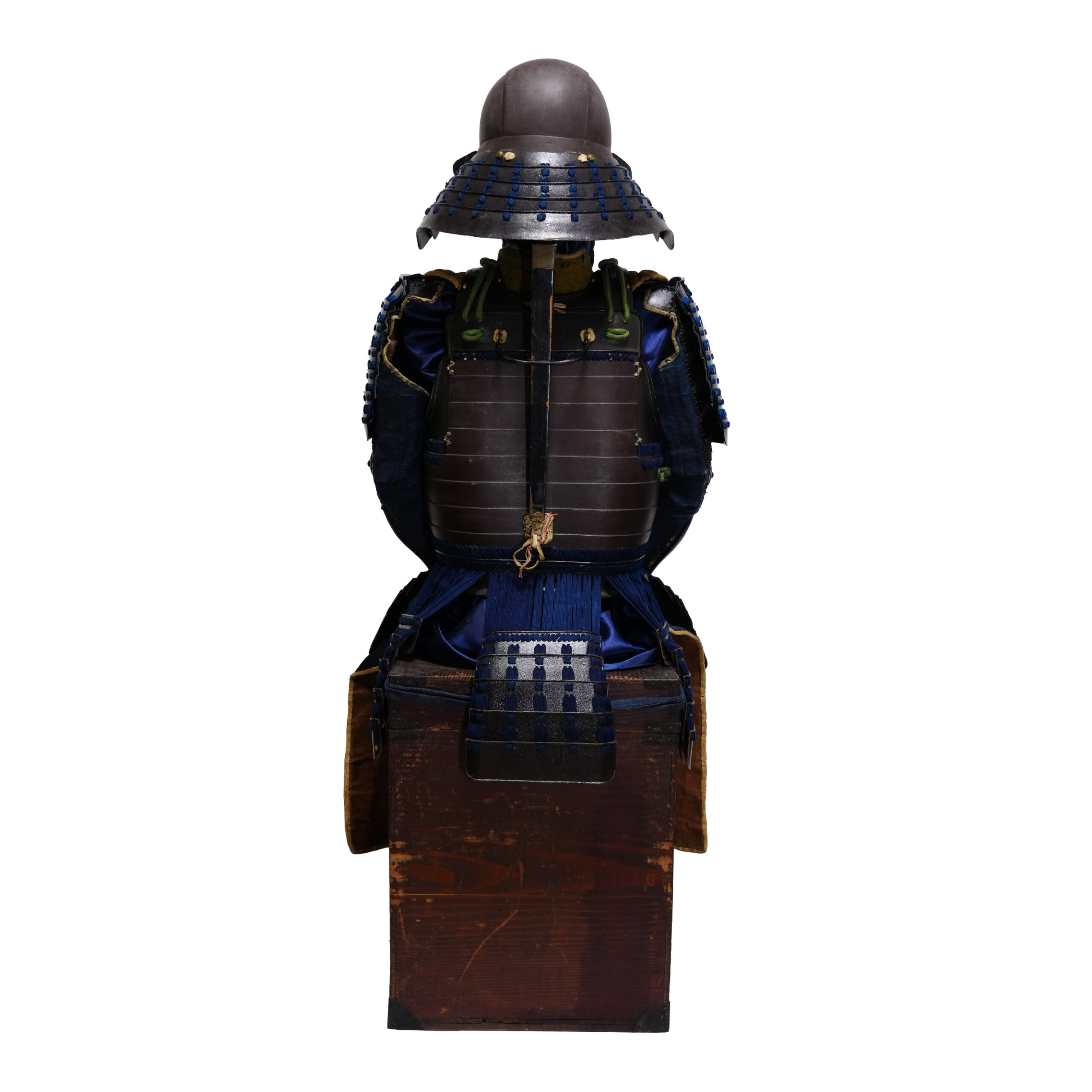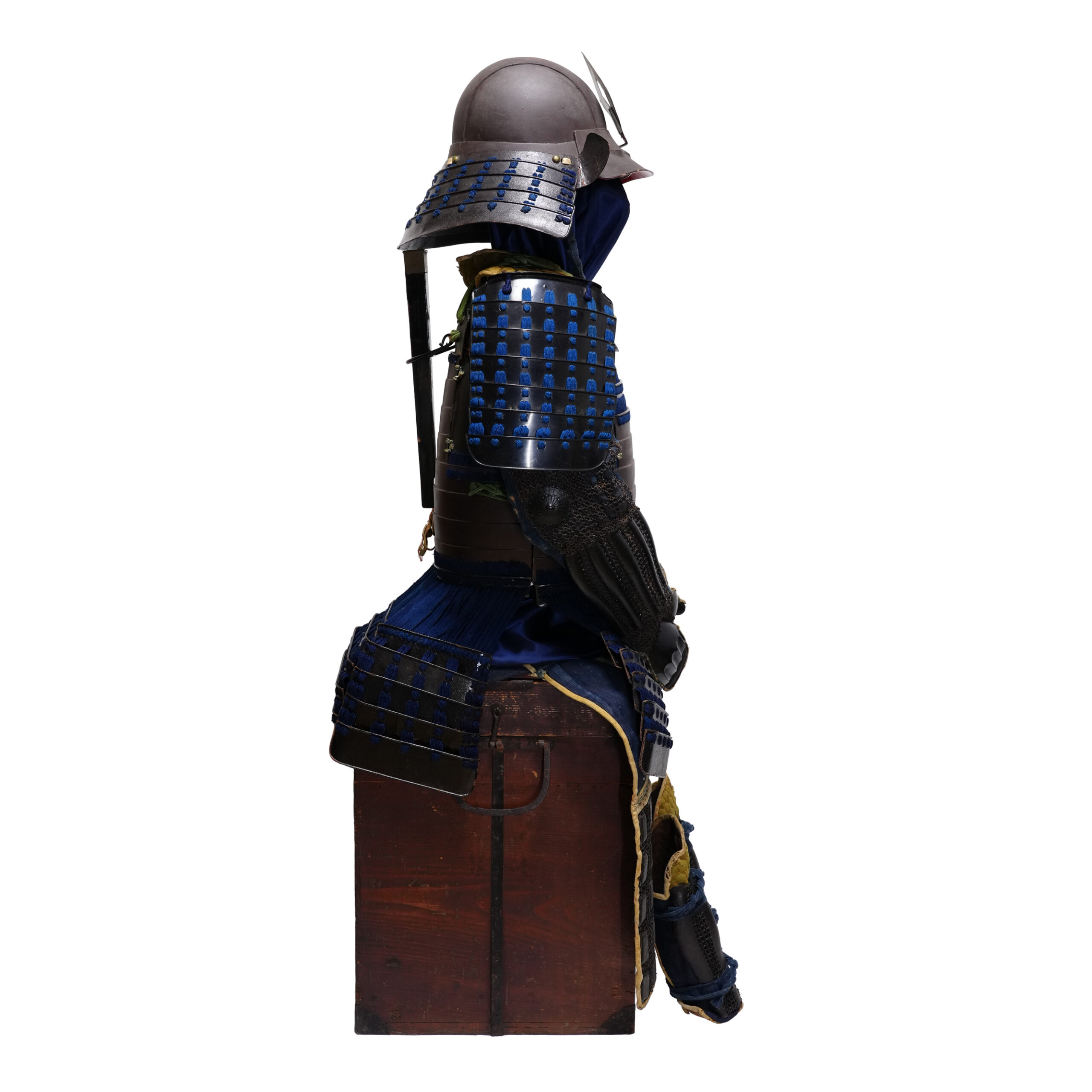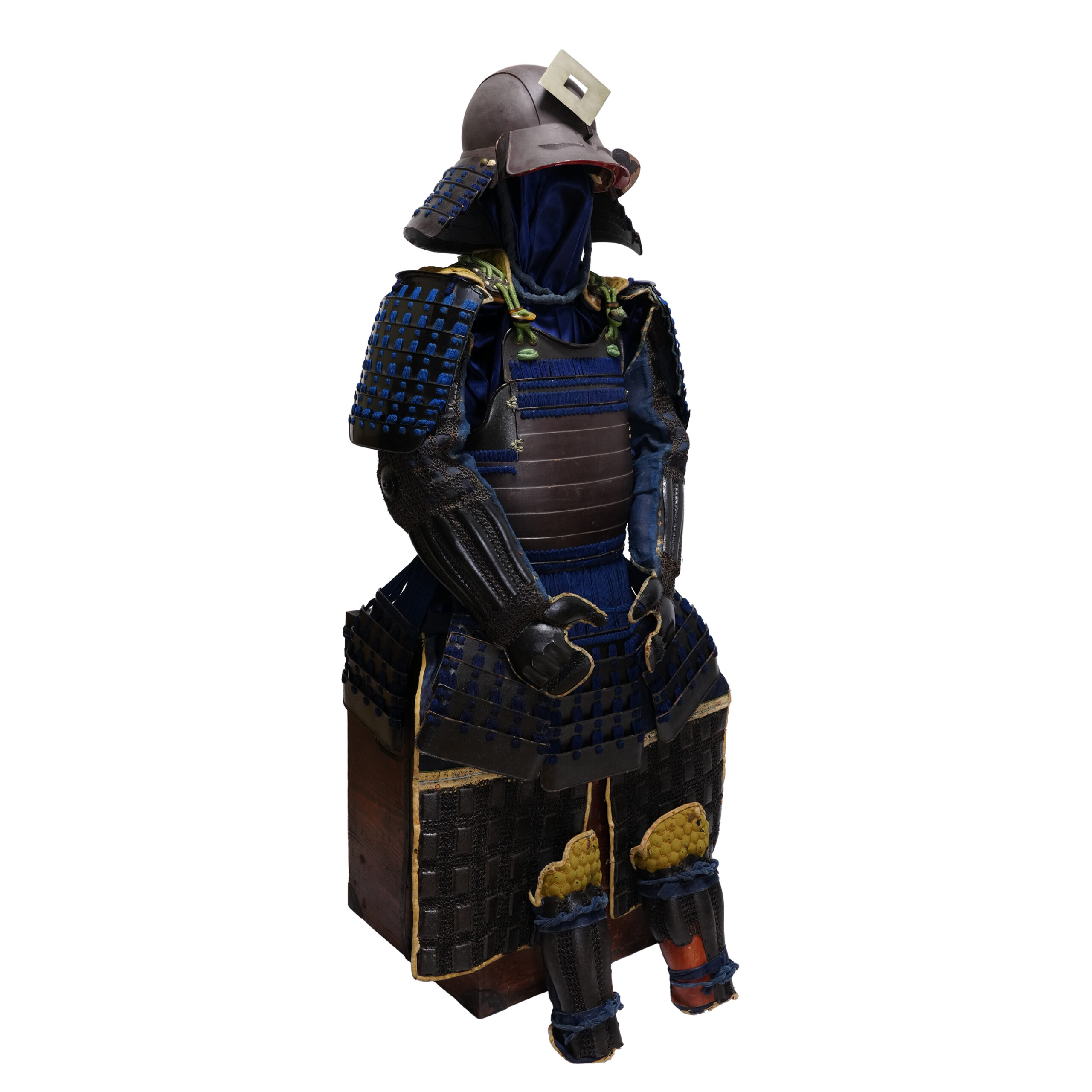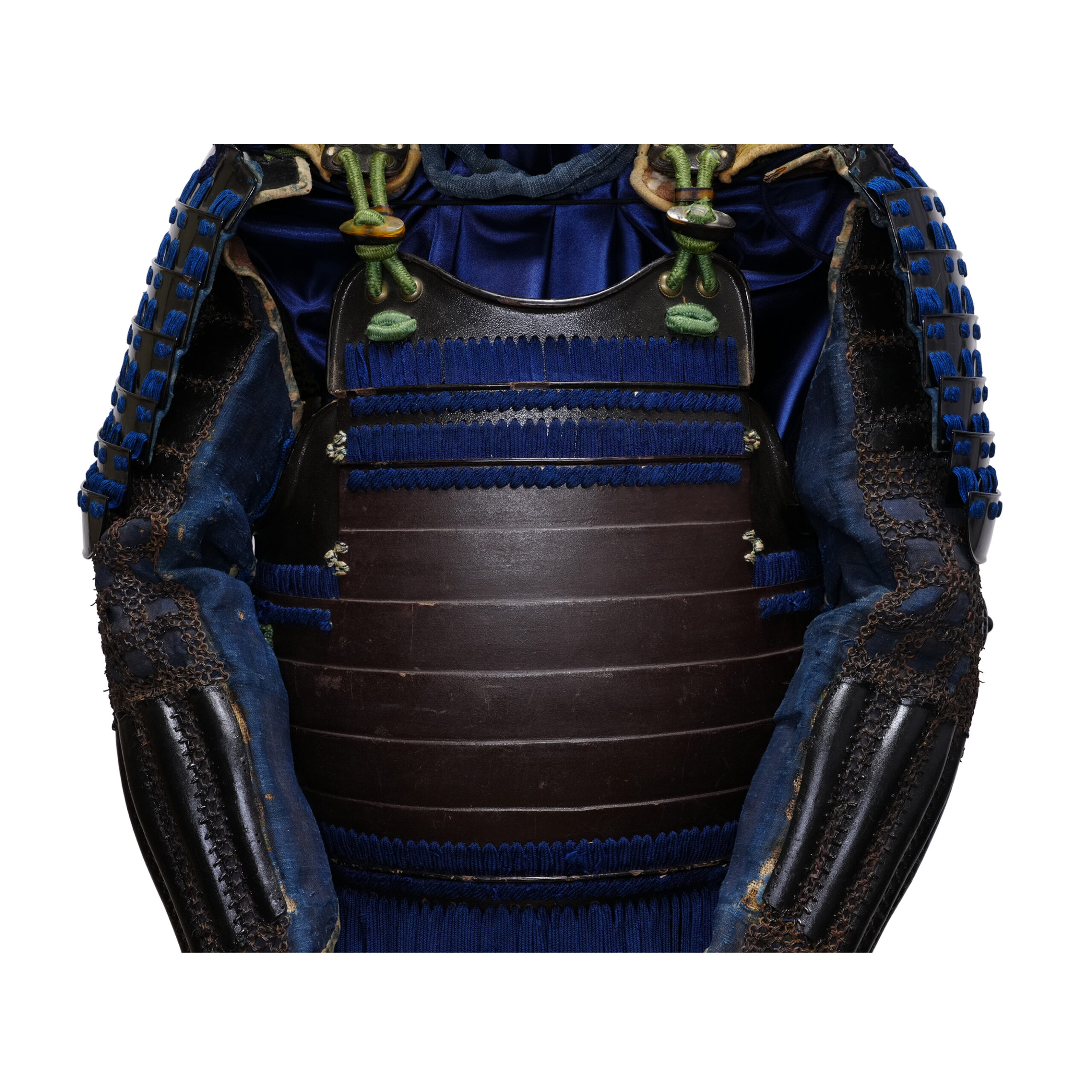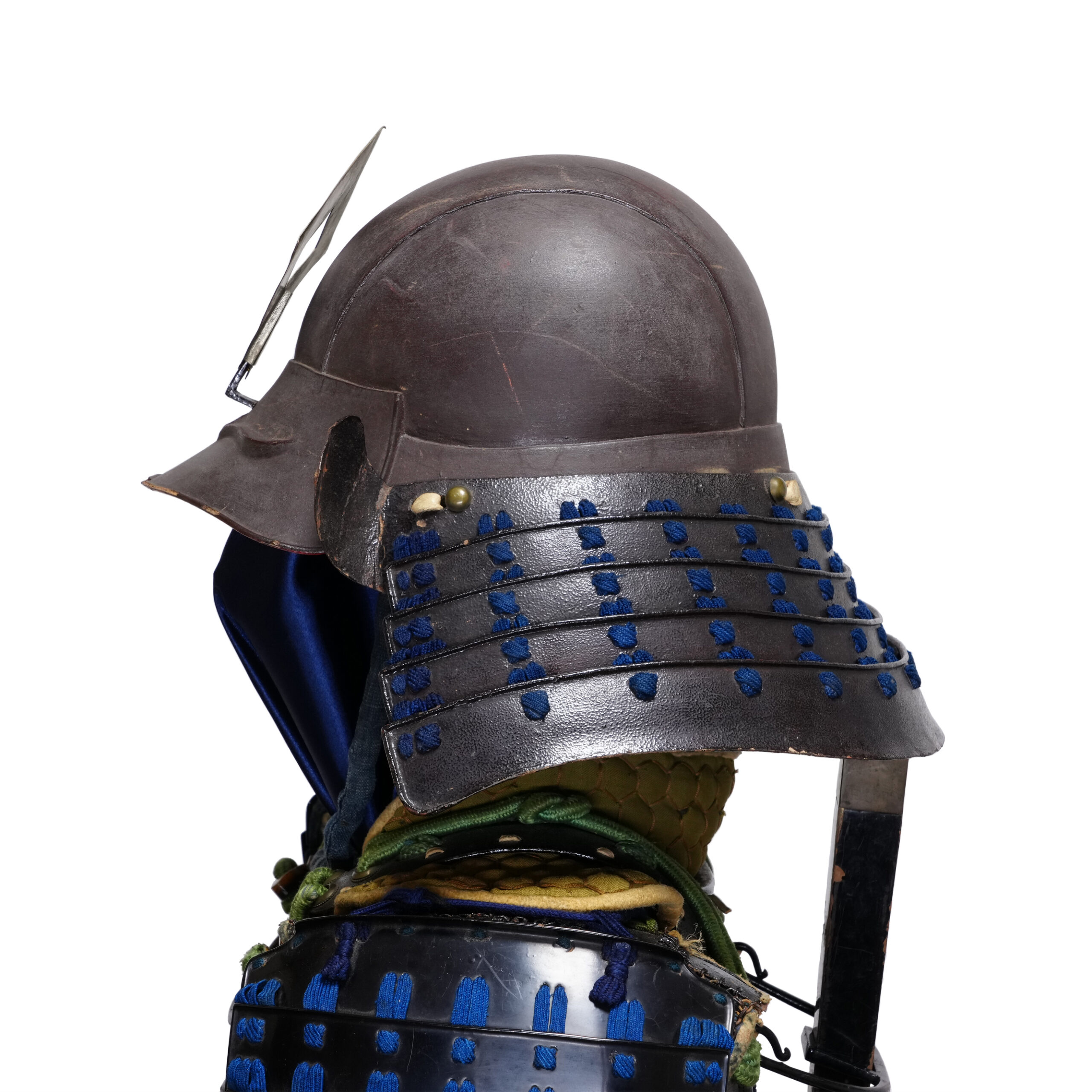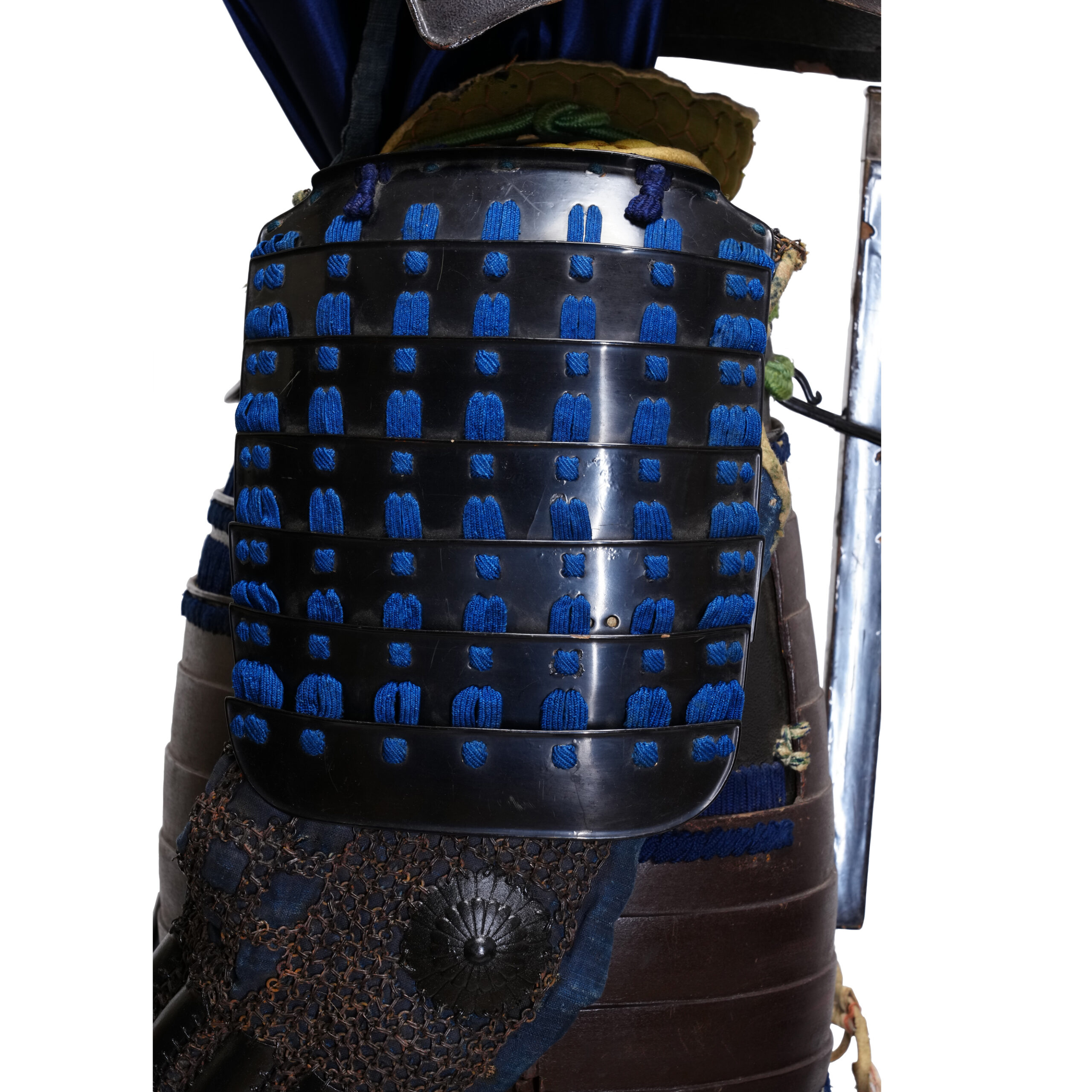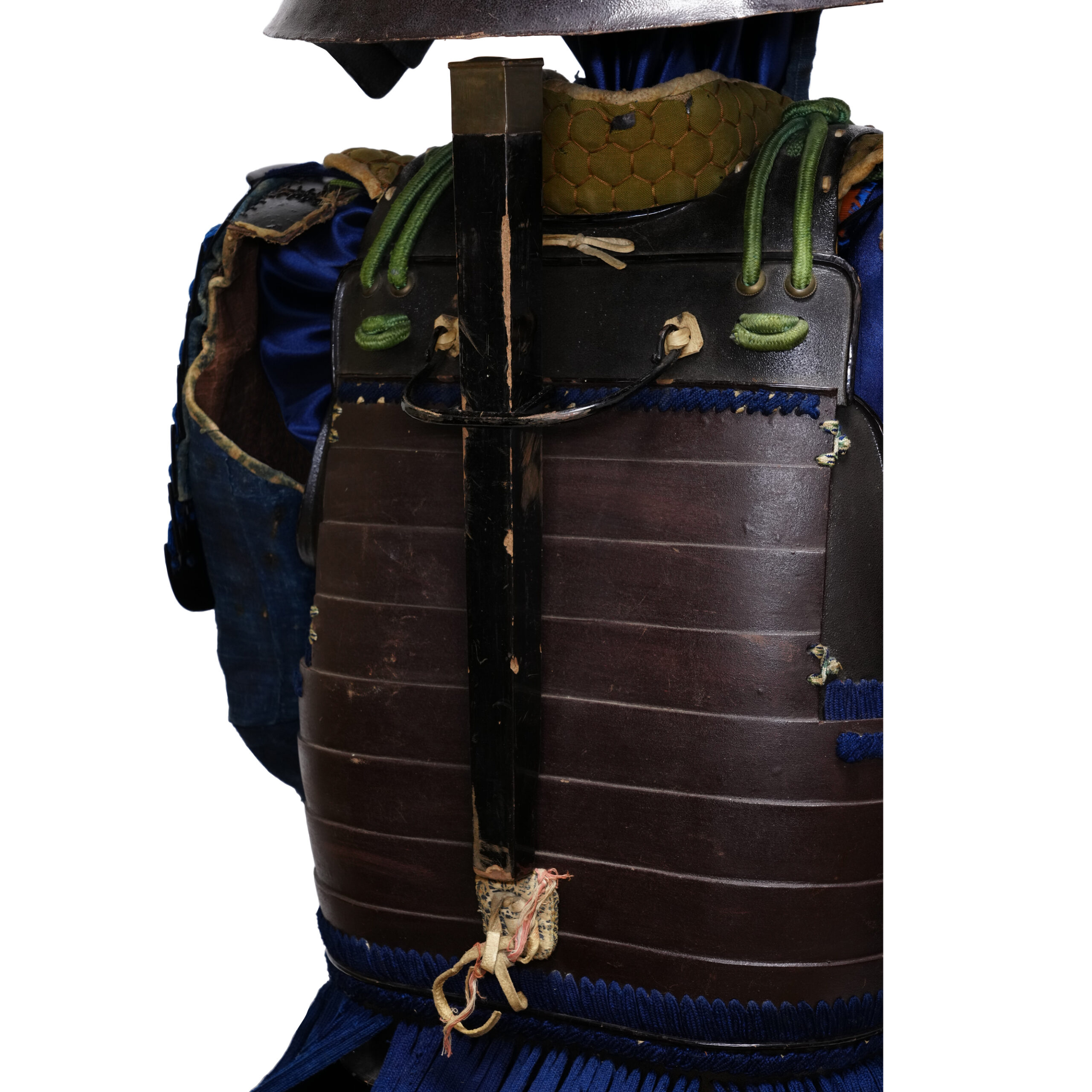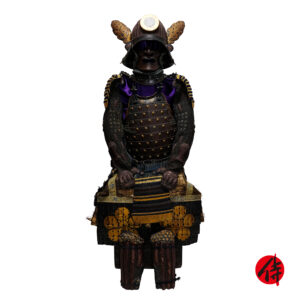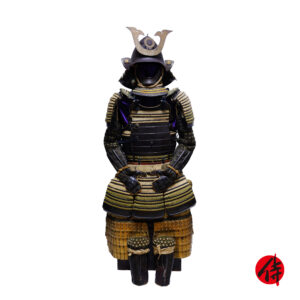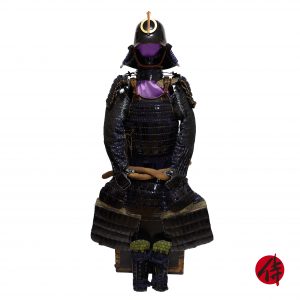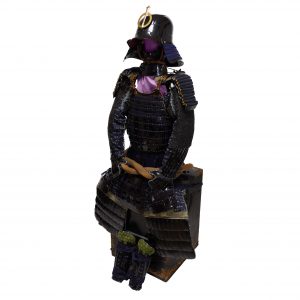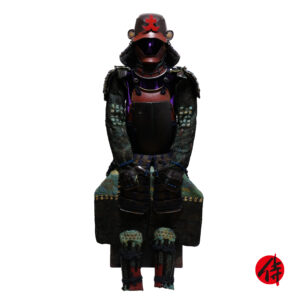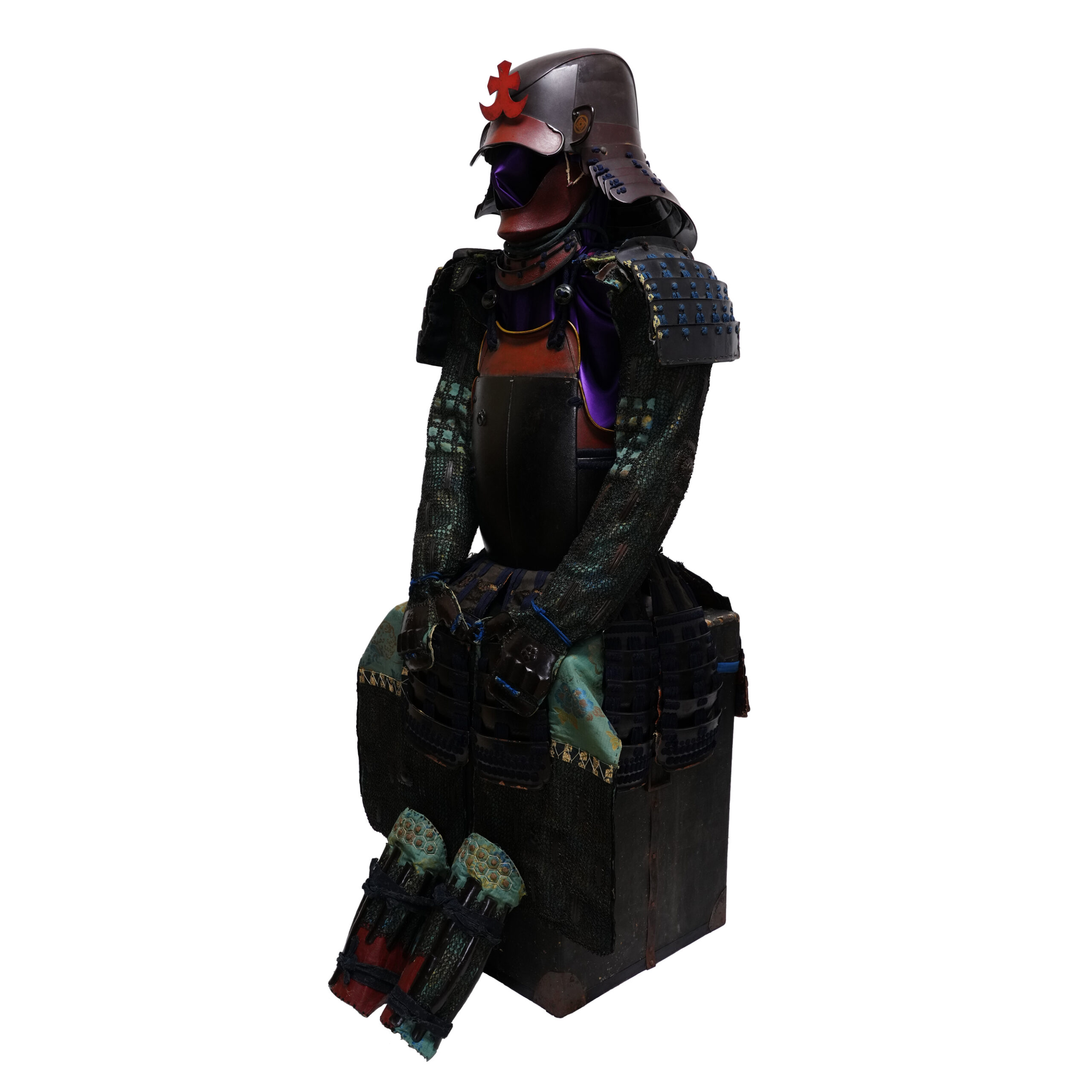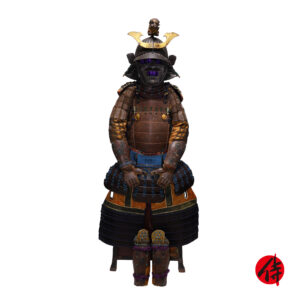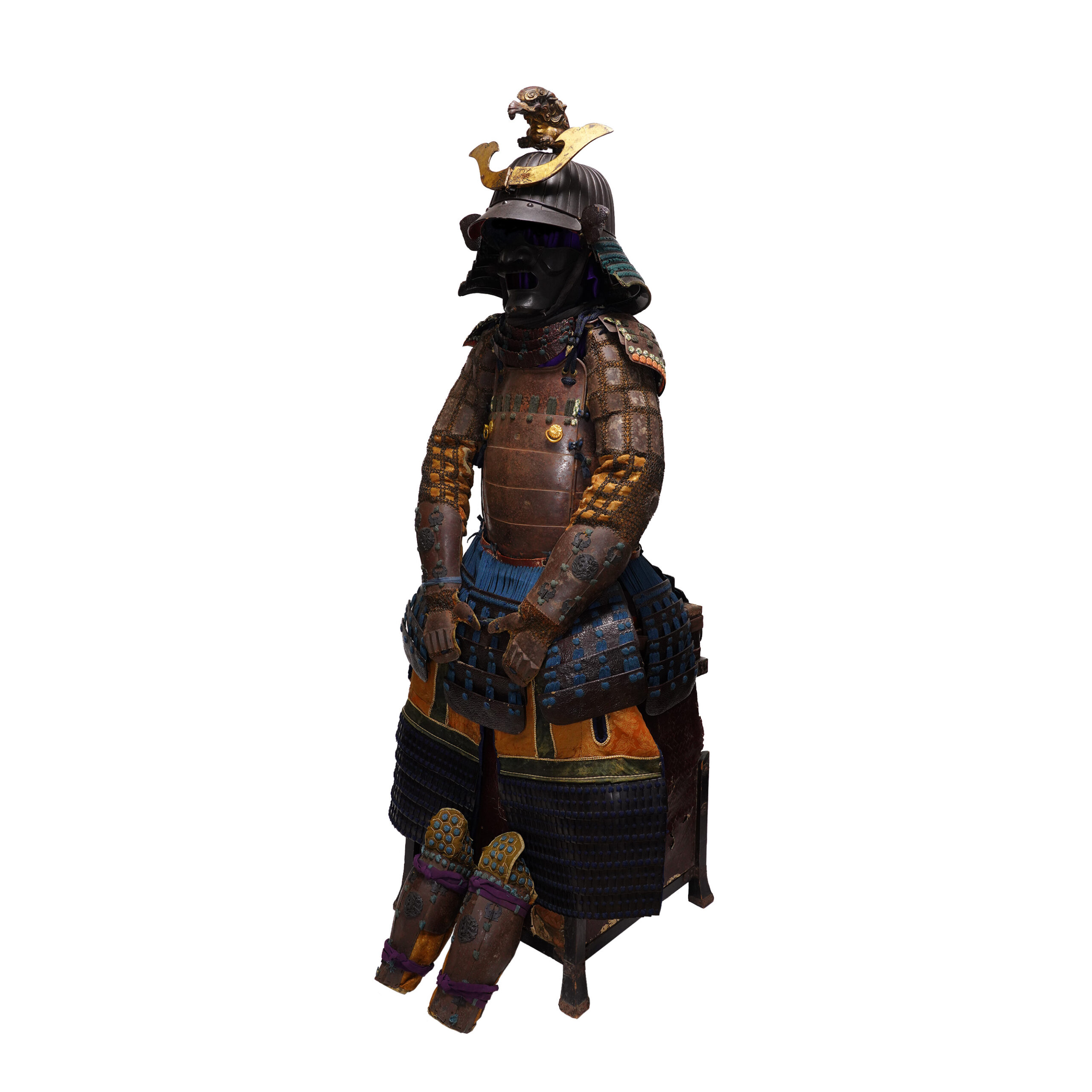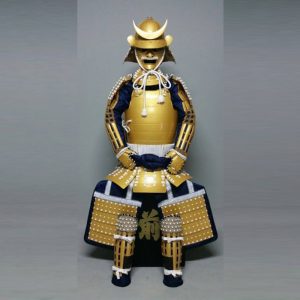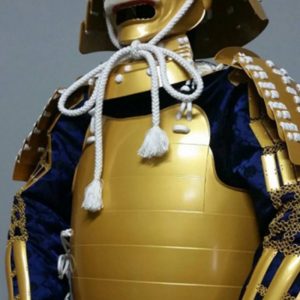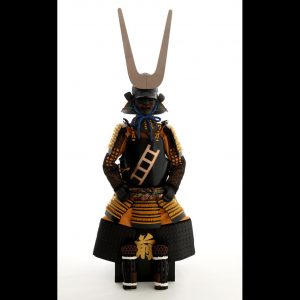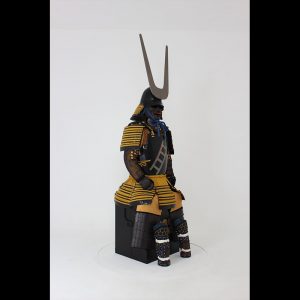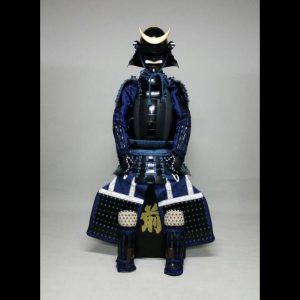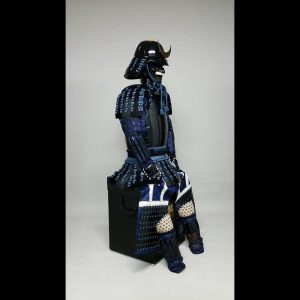Antique Late Edo Period Samurai Armor Tokubetsu Kicho Shiryo Certificate (A-28)
Period: Late Edo Period
appraised by The Association for the Research and Preservation of Japanese Helmets and Armor

Kabuto (helmet)
■Helmet bowl: Zunari Kabuto
The Kabuto (兜, helmet) is a protector for the head. When people started using the Kabuto, it was initially designed for practical use. However, the principal purpose of its design has changed with time; Samurais tried to express their dignity, personality, or religion by wearing the characteristic designed Kabutos. According to a theory, these uniquely designed Kabutos were made from the late Muromachi (室町後期, 1467-1573) to the Edo period (江戸, 1603-1868). This type of Kabuto is categorized as the Kawari Kabuto (変わり兜), and a variety of materials were used to create them. For example, animal fur, seashells, plants, and paper were used as materials for decoration.
This Kabuto has a rounded shape that follows the shape of a head. We believe this Kabuto is categorized as the Zunari Kabuto (頭形兜). It is said that this type of Kabutos were originated in the late Heian period (平安, Heian period lasted from 794 to 1185). Zunari Kabutos are usually made up of five plates glued together, but exceptions are made from a single plate hammered out. This style of Kabutos consisted of a few iron plates and were relatively inexpensive to manufacture. Therefore, Zunari Kabutos were widely used after the Warring States period. At the end of the Muromachi period, when battles grew in scale, and the demand for Zunari Kabutos increased, artisans improved Zunari Kaboutos. In this period, Zunari Kabutos had a more rounded silhouette than straight Hachi (鉢, bowl part of Kabuto) and were thought to have been designed to withstand potent impact weapons such as spears and guns.


■Shikoro (side neck guard):
Iron plates laced with navy blue threads.
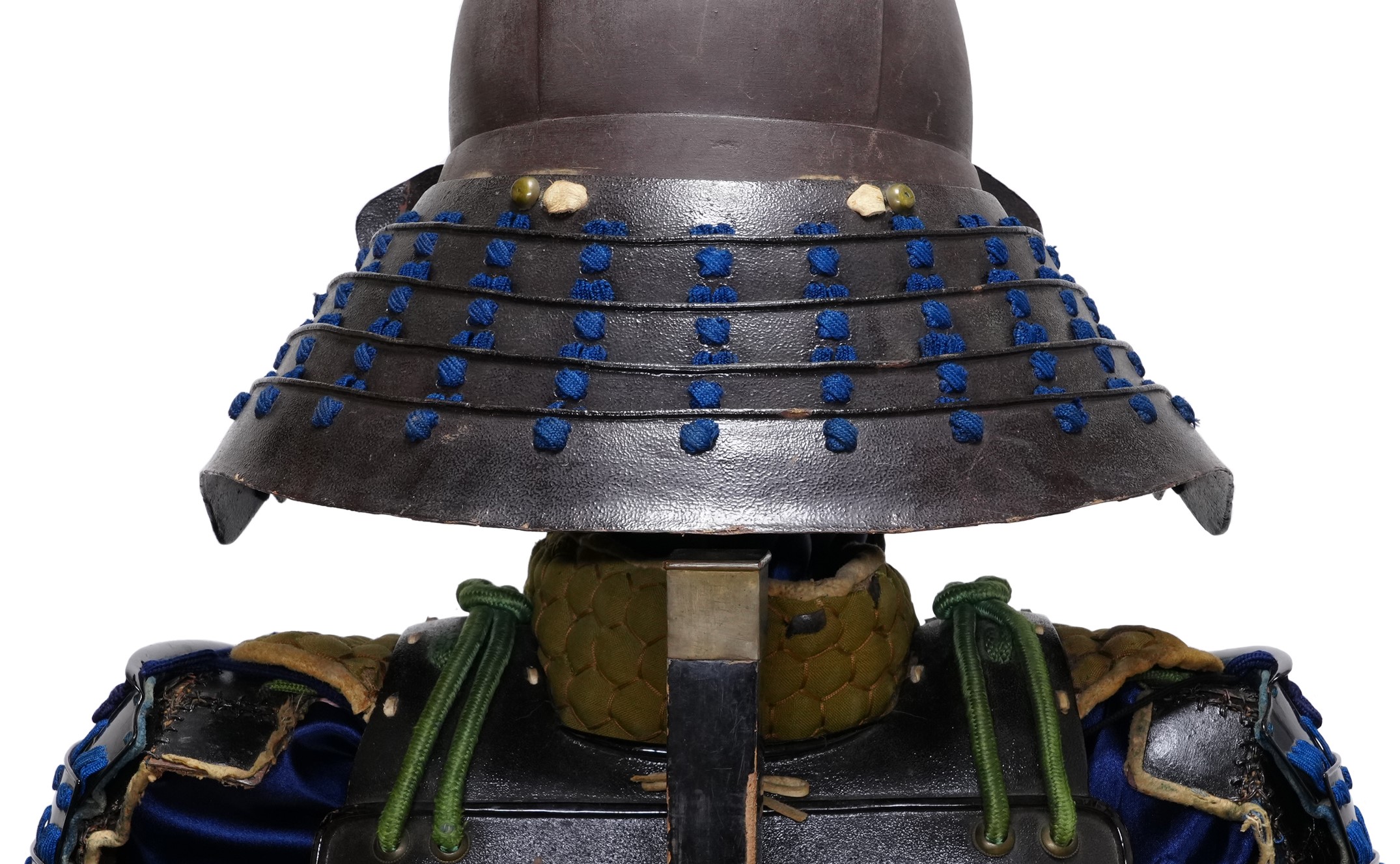
■Fukikaeshi (side neck guard):
The Fukikaeshi (吹き返し) is both ends of a Kabuto. It protects the face from swords and also shows its beautiful workmanship. Family crests are sometimes designed on this part. This Kabuto’s Fukikaeshi has a simple look. Some pieces of its metal have come off, presumably due to aging and being used on battlefields in the past. Instead of gorgeous decorations with gold or silver, we hope you will enjoy them as antique textures that show this armor’s long history.
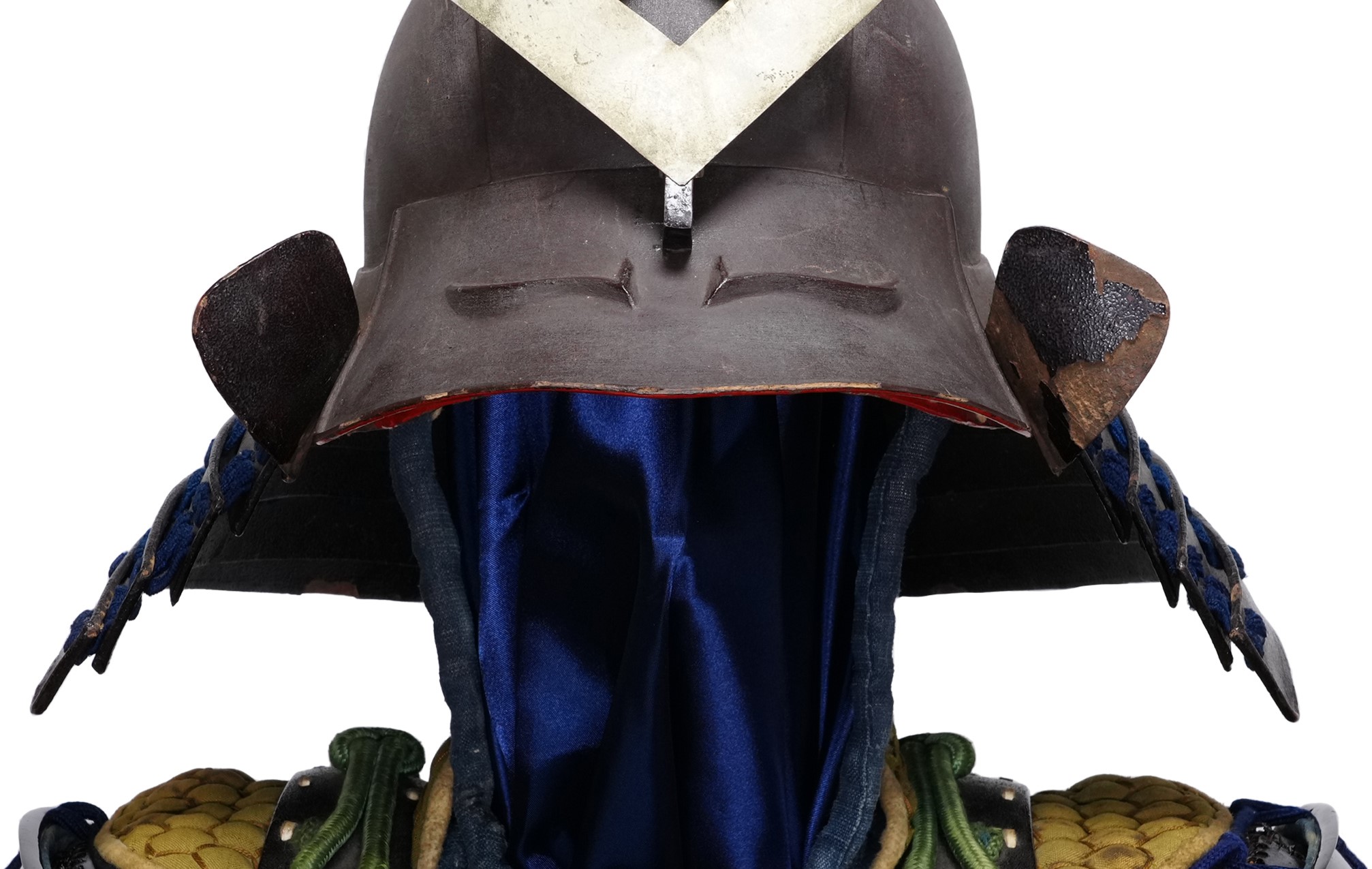
■Menpo (face guard):
This armor does not have Menpo.
■ Maedate (Front decoration): Sumitate Hitotsume Mon or Kuginuki Mon
We are considering two possibilities for the motif of this Maedatemono (前立物, front decoration). One of our ideas is that the Sumitate Hitotsume Mon (隅立て一つ目紋). This design is also simply called the Meyui (目結) or Hitotsume (一つ目). It is categorized as the Menyui Mon (目結紋). The name Meyui comes from the tie-dyeing of the dyeing pattern. Therefore, the Meyui Mon has another name Kanoko Shibori (鹿子絞り) and Koukechi (纐纈). It is said this design was used for many arms; we imagine it was one of the familiar motifs to Samurai warriors.
The second point of view is the Kuginuki Mon (釘抜紋). This pattern has almost the same appearance as the crest mentioned above. When comparing these two crests, it is said that the one with a slightly larger hole inside the square is the Kuginuki Mon. A Kuginuki (釘抜き) is a nail puller which is a tool used to remove hammered nails. Due to the pronunciation “Kuginuki,” this crest was associated with the following expressions; Kugi-wo Nuku (釘を抜く, pull out nails), Kuki-wo Nuku (九城を抜く, pass nine castles). In this way, there is a theory that it came to be used among Samurai families because of the auspiciousness of ‘capturing enemy castles.’ Since its simple design stands out even from a distance, and because it could be easily drawn as a banner mark on battlefields, lots of Samurai families used the Kuginuki Mon.
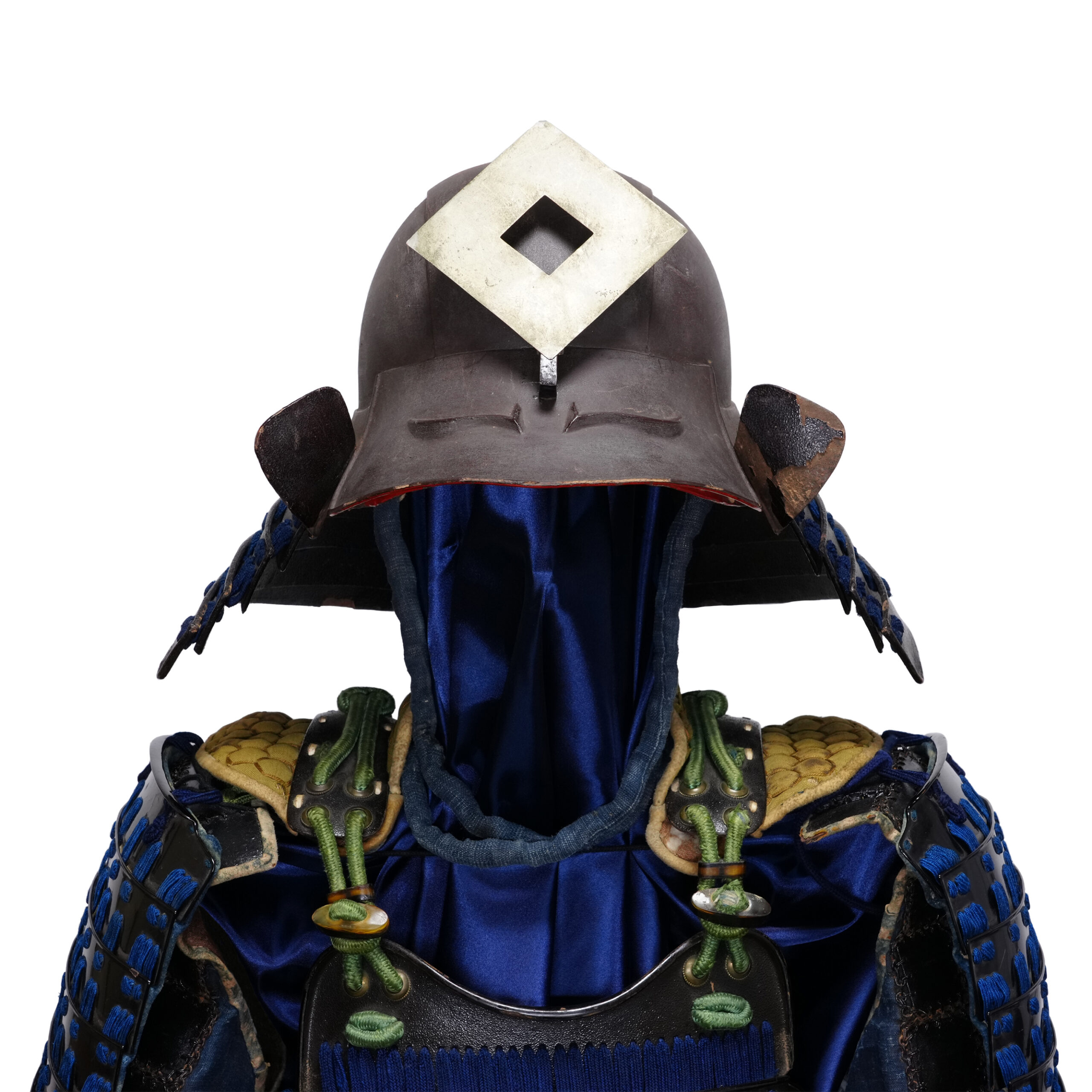
Armor
■Dō (cuirass): Okegawa Nimai Dō
Nimai Dō is a kind of cuirass for Tousei Gusoku (当世具足, developed armor style). Nimai Dō (二枚胴) was named after the fact that Nimai (二枚) means two plates and Dō (胴) means torso in Japanese. Instead of using a large number of small lamellar plates called Kozane (小札), this cuirass used large iron plates riveted.
The name Okegawa (桶側) came from the fact that the shape of this cuirass resembles the Gawa (側, side) of Oke (桶, Japanese wooden tub). The body armor part can usually be separated into two pieces and connected with a hinge. Generally, a hinge is located on the left side, and you could tighten a cuirass on the right side. The Okegawa Dō was relatively easy to make and had high strength; therefore, it is said this cuirass style became popular in the latter half of the Muromachi (室町, 1336-1573) period.
■Kusazuri (skirt of plates attached to the cuirass):
Lacquered iron Kusazuri laced with navy blue threads. As the pictures below show, some Kusazuris have portions where the metal surface is peeled off. However, the cords for the Odoshi (縅, a technique for armor tying boards together with cords such as leather or thread) are relatively in good condition, so each plate is tied without coming off.
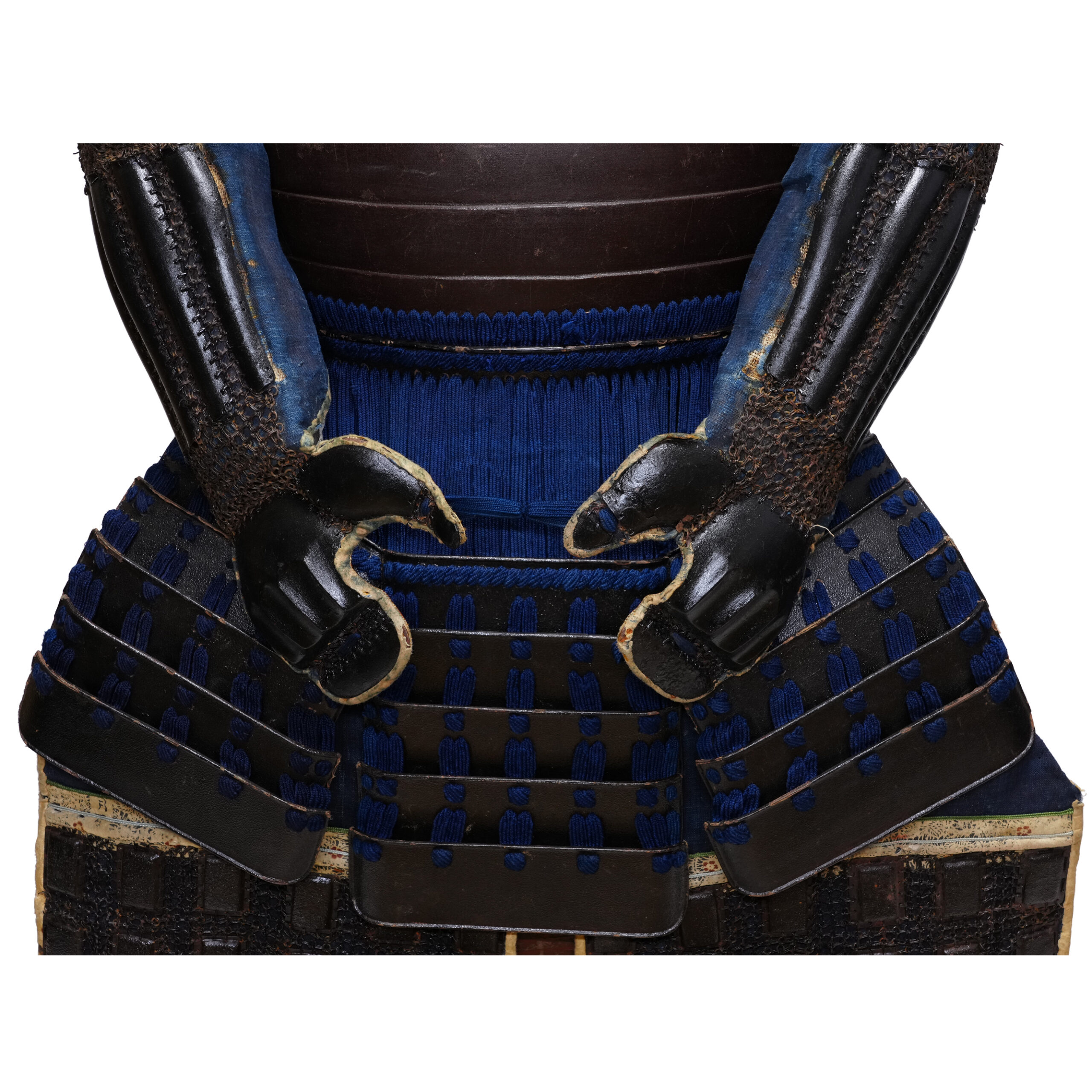
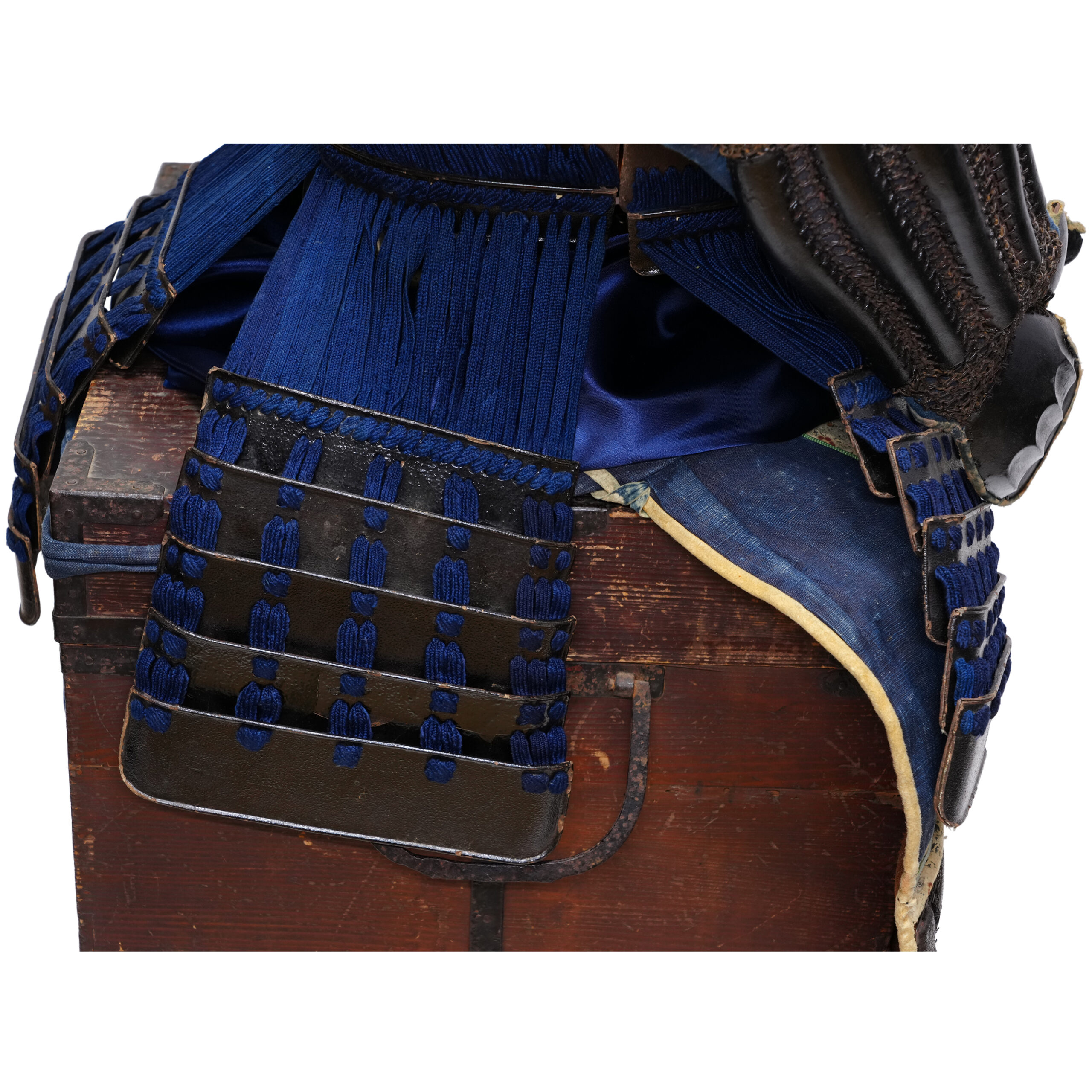
Small parts
■Kote (armored sleeves):
Intricate iron chain mail with silk.
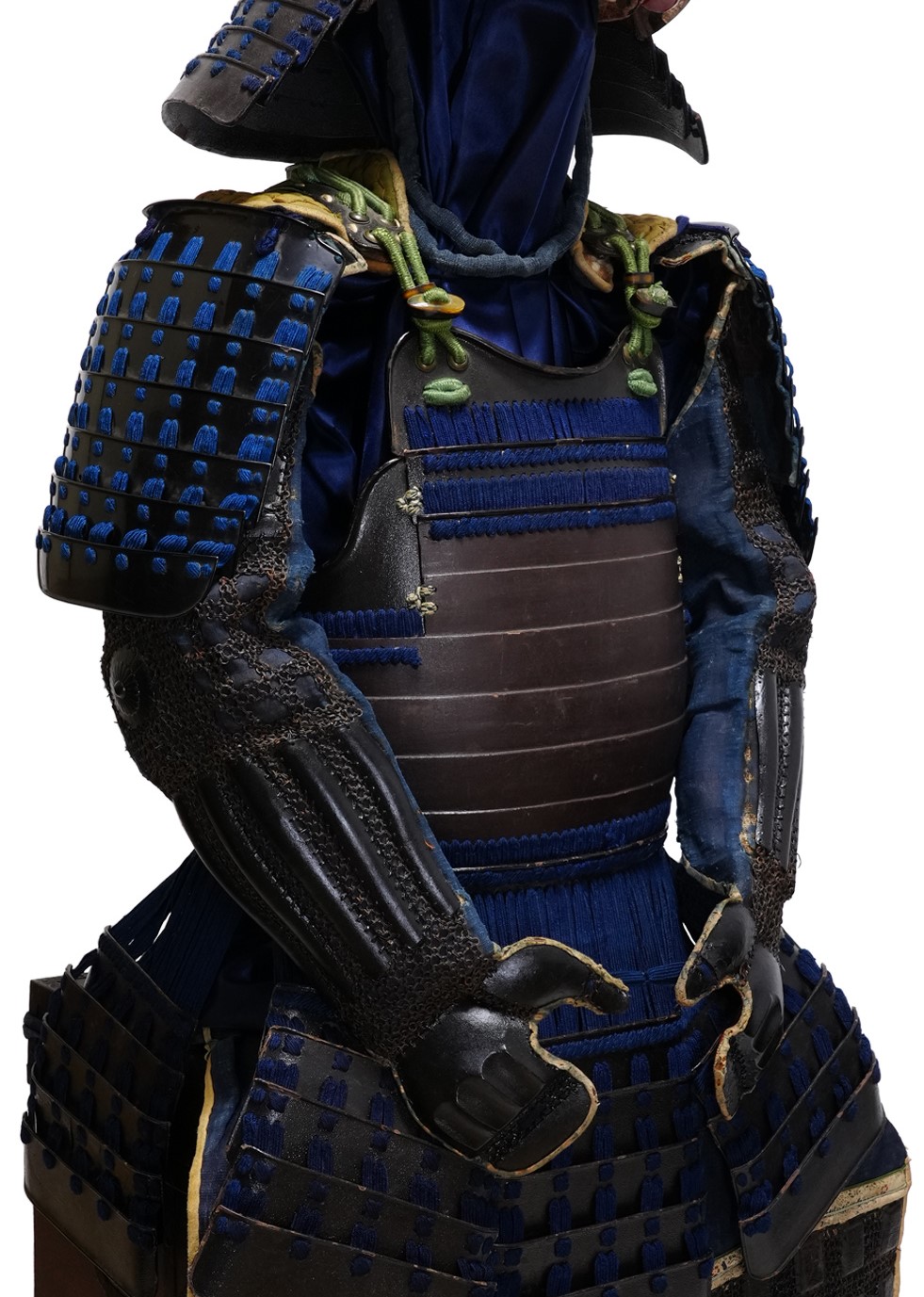
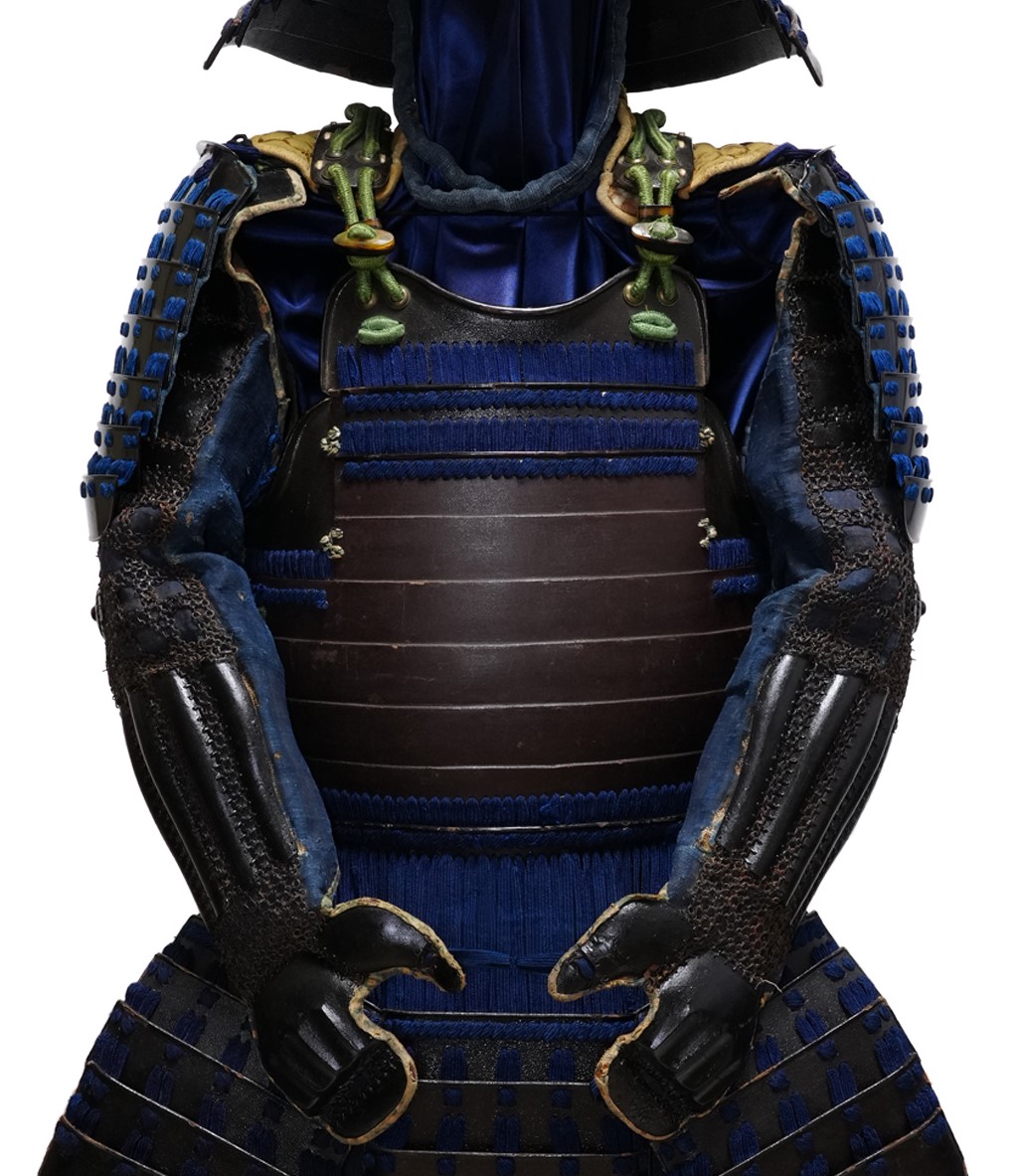
■Haidate (thigh protection):
The Haidate (佩楯) is a thigh guard. Chain mail and iron plates are attached to its cloth.

■Suneate (shin guard):
The Kikkou (亀甲, turtle’s shell) pattern is used for the cloth of the Suneate (脛当). It is a continuous geometric pattern connecting regular hexagons up and down. A theory says that this design was brought from China and the Korean Peninsula during the Asuka (飛鳥, 592-710) and Nara (奈良, 710-794) periods. A proverb says turtles live long lives; therefore, turtle and turtle shell patterns represent longevity. In addition, as this continuous hexagonal pattern does not get out of its shape, it is said people wished for eternal prosperity by using this design.
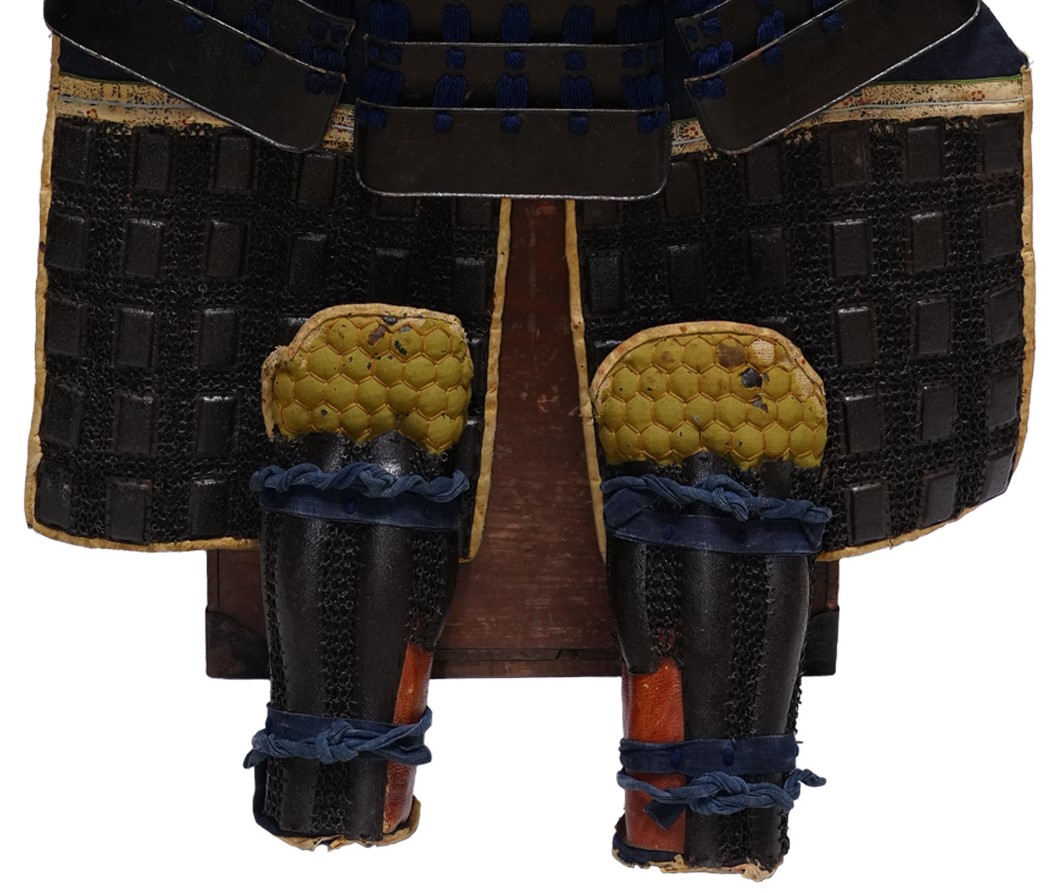
■Gattari (Sashimono holder):
If you focus on the back of this armor, you will find a semi-circular metal frame attached. It is a gear called the Gattari (合当理) that supports the upper part of the Sashimono (指物, a frag or decorative sign installed at the back of armor). And the Uketsutsu (受筒)/ Sashidutsu (指筒) is a tube to store a Sashimono. Samurai warriors judged their sides and enemies on the battlefields by checking the motifs designed for flags. Especially in group battles with infantry, this method was very effective because they could instantly identify affiliations.

Certification: Tokubetsu Kicho Shiryo Certificate (No. 2036)
On May 14th 2023, this armor was appraised as a Tokubetsu Kicho Shiryo by The Association for the Research and Preservation of Japanese Helmets and Armor, which is the most trusted Japanese armor appraiser in Japan. This association is also known as Nihon Katchu Bugu Kenkyu Hozonkai (日本甲冑武具研究保存会). Tokubestu Kicho Shiryo (特別貴重資料) means special rare article. It is ranked as the third highest of five rankings.
The paper mentions the armor was made in the late Edo period (late 18th- mid 19th century). You can receive this original authentication paper.
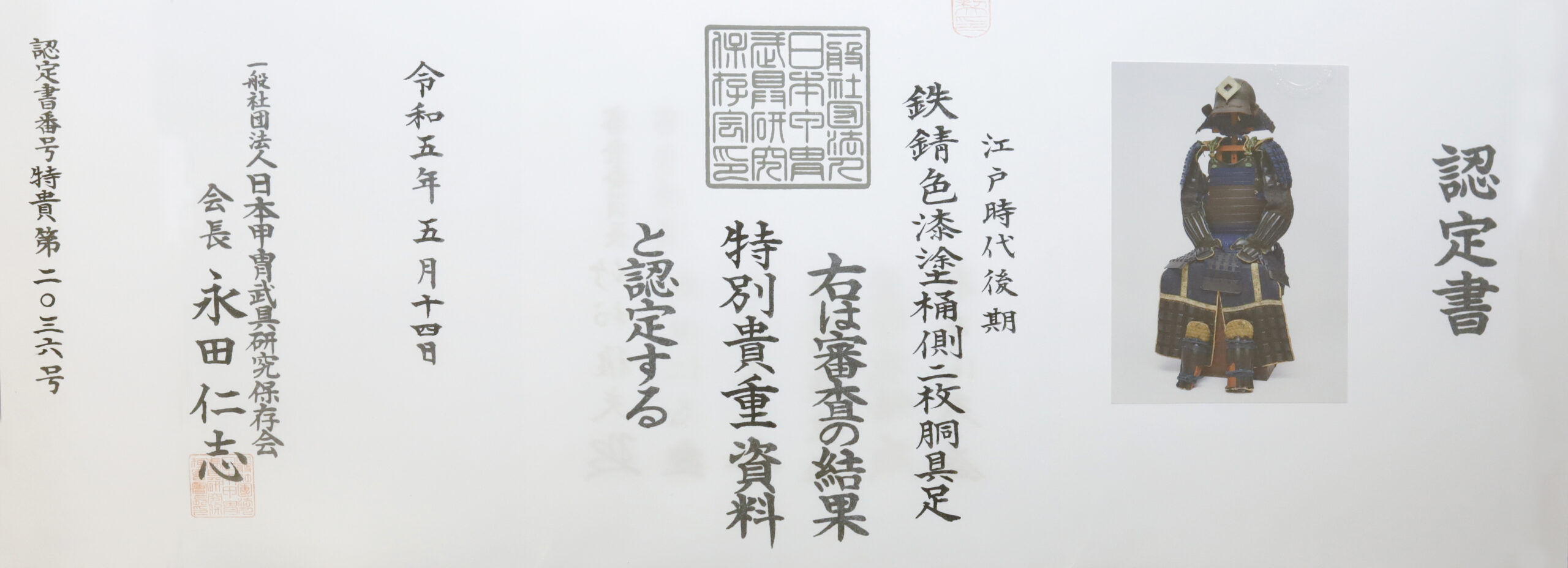
An English translation of the certificate is available on request. We won’t charge any additional fee.
【About us】
Samurai Museum is located in Tokyo, Japan, exhibiting antique artifacts related to the Samurai history. Samurai Museum Shop is the place for those who are interested in Japanese culture and craftsmanship. We deal with antique Samurai swords/armor, traditional crafts made in Japan and so on.
【Antique Japanese Armor and Export process】
After receiving the full payment from you, we will apply for its export permit from the agency for Cultural Affairs to legally export the antique Samurai armor to other countries. It normally takes around 2-4 weeks to receive this permit. And we would like you to expect at least 1-1.5 months for your order to arrive at your given address after you ordered.
【Payment method】
We accept payment through Stripe (Credit card), PayPal, Apple Pay or ChromePay, all of which are secure payment methods. Also, you don’t need to make an account on Stripe for the checkout. If you prefer other payment method, please contact us. You may either pay in JPY, USD, AUD, CAD, EUR, CHF or GBP. The price is set in Japanese Yen. Prices in other currencies are automatically calculated based on the latest exchange rate.

【Shipping duration】
We normally ship via EMS (Express Mail Service) provided by Japan Post. It usually takes at least 5-14 days to deliver the package after you place an order. We offer Free International Shipping as long as we can ship your order by EMS. If you prefer other shipping carriers, please contact us.
We will inform you of the order’s tracking number via email. Please make sure you fill out your valid email address correctly.
*Please keep in mind that due to the spread of COVID-19, there might be possible delays in delivery. If you like to make sure if EMS shipping is available to your country, please contact us.

【How to make sure the condition】
Please keep in mind that what you are going to purchase is an antique item. We uploaded high resolution photos for you to check its condition thoroughly. If you like to see more photos with different angles, please feel free to contact us. We will be happy to send them to you so that you can make informed decision. It is essential for us to know that you are happy with your choice of a sword. and we are prepared to use the best of our ability to serve you.
【How To Contact Us】
Please contact us through email, Facebook Messenger or Live Chat if you have any questions. You can find each icon on the right side of the website. Please click one of them to reach us. We will reply to you within 1-2 business days.
【How To Preserve Antique Samurai Armor】
Dryness, humidity, and bad ventilation might deteriorate the condition of antique Samurai armor. The best temperature to preserve Samurai armor is around 20℃ in Celsius, and humidity should be about 60%. Direct sunlight should be avoided. We recommend storing armors in a room with good ventilation. If you like to display them outside the boxes for a prolonged time, we suggest using a glass case in order for dust not to be accumulated easily. In case you don’t use a glass case, please make sure to regularly dust off from the armor by using a soft brush made of delicate cloth or brush for painting.
If you like to know more about the preservation of this armor, please feel free to contact us.
